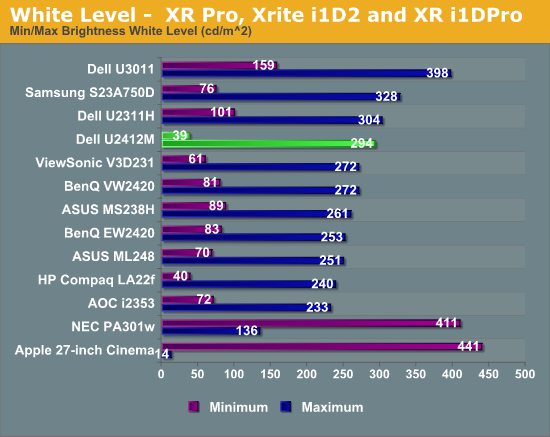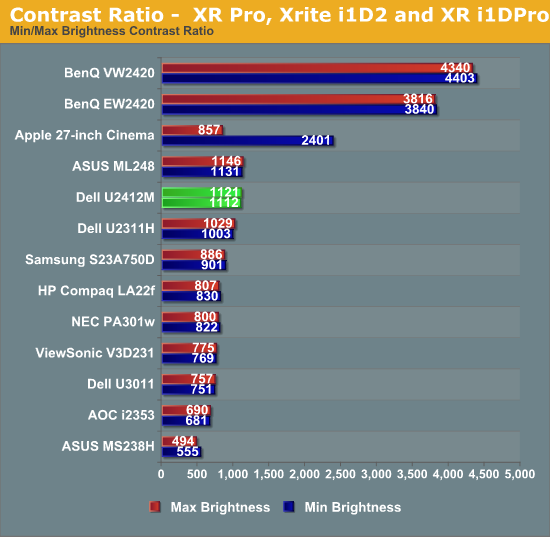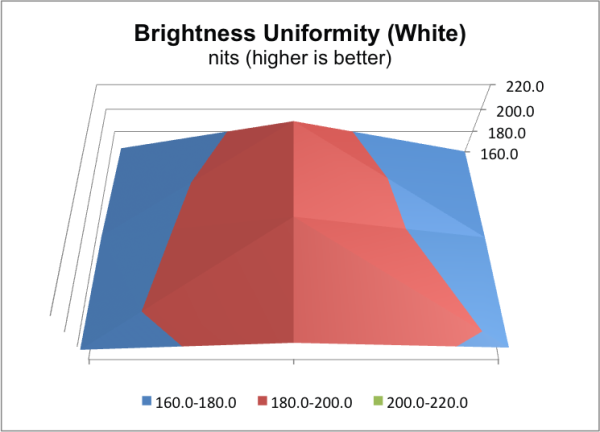Dell U2412M - 16:10 IPS without Breaking the Bank
by Chris Heinonen on February 28, 2012 9:00 AM ESTDell U2412M Brightness and Contrast
Despite the larger size of the display compared to recent 23” monitors I have reviewed, the U2412M says it can produce 300 nits of light at maximum output, which should certainly be bright enough for anyone to use. It’s worth noting that I usually set the display around 5 nits too high before calibration, to allow for a little headroom when ColorEyes generates the curves. However this also means that maximum light output, once calibrated, might be around 5% lower than maximum due to the curves inside the ICC profile.

Despite this possible limitation, the Dell still put out 294 nits at maximum brightness after calibration, and 39 nits at minimum brightness. This was plenty bright for my work area, even with bright overhead lights, and the combination of the high brightness and anti-glare coating made it easy to see the screen.
The weak area for IPS screens has always been the black levels, with them being much higher than those from VA based displays. The U2412M did well here, out performing all recent non-VA displays with a nice, low black level.

With this combination of black level and a very bright screen, we would expect to see a decent contrast ratio to come out as well, and the Dell delivers here.

Beating the specified number by over 10% is always nice to see, and the contrast on the Dell is very nice. It easily outperforms most TN displays, though it's not able to compete with the combination of LED lighting and a VA panel from BenQ. It was also very stable across the spectrum, with virtually identical ratios at maximum and minimum brightness.
While the center stayed nice and bright, the edges showed a good amount of fall off in comparison, and an overall variance of around 6%. The areas with higher brightness uniformity issues were also the areas with higher dE values on the uniformity testing, just as we expected. Looking at black uniformity, thanks to the bright corners this wound up even worse, with a variance of around 14%.
Taken as a whole, the contrast ratios are good, and while there is light fall-off at the edges of the display, it does not seem to have a noticeable effect on color quality.












143 Comments
View All Comments
Braumin - Tuesday, February 28, 2012 - link
I bought this when it first came out. I had been looking at an IPS monitor to replace my aging S-PVA monitor. I really hate TN.The price is just amazing on this, and the quality is top notch.
No, it doesn't have everything that everyone needs, but it has exactly what I needed.
Great review!
Oxford Guy - Tuesday, February 28, 2012 - link
What's wrong with the monitor you have? Is the backlight becoming too weak or what?Braumin - Wednesday, February 29, 2012 - link
19" 1280x1024 was good when I got it, but really not enough desktop space. I much prefer the widescreen for gaming and such.TegiriNenashi - Tuesday, February 28, 2012 - link
The statement that 16:9 panels were introduced at lower prices is false. I clearly remeber that the "latest and greatest" "Full HD" were rarity and commanded a premium, compared to "boring" 1920x1200 panels, which could be found anywhere from $200 and up.JarredWalton - Tuesday, February 28, 2012 - link
I'm sorry, but I'll have to disagree. I don't know that I've ever seen a new 24" 1920x1200 display for under $250, period. Not even the cheap, TN, low quality displays with now height adjustment have gotten that low. But 1080p, while perhaps there were a few more expensive models initially, rapidly dropped into the <$250 range for 23-24" models, and now they start at around $170 (compared to $270 for the cheapest 1920x1200 LCD).Zoomer - Tuesday, February 28, 2012 - link
Remember back in Sept when some idiot mentioned HP was divesting it's PC division? The ZR24w dropped to $250 after rebate then.And the vw266 was under $250 for some time. Not technically 24", but I figure being bigger shouldn't count against it.
kmmatney - Tuesday, February 28, 2012 - link
Those are rare exceptions, but for the most part 1920 x 1200 monitors were always pretty expensive, and it wasn't until the 1080p monitors came out that prices started to really drop. My Soyo 24" MVA panel was a bargain at $299 when it came out, and after these sold out there wasn't anything near that price for 2 years in terms of price and quality.papapapapapapapababy - Tuesday, February 28, 2012 - link
stoper reading at led backlight, ill stick with my u2711... led backligth makes me sick( literally)
Death666Angel - Tuesday, February 28, 2012 - link
Not sure why you would want to change to a 24" model from a 27" inch one, but I'll bite:The PWM for brightness makes you sick, not the LED technology itself. The HP ZR2740w has no PWM and regulates brightness continually. See for example: http://www.prad.de/new/monitore/test/2012/test-hp-...
Oxford Guy - Tuesday, February 28, 2012 - link
Every LCD monitor review should measure flicker.I really want to get a constant control backlight, but I like my A-MVA panel's high contrast ratio.
If review sites put pressure on manufacturers by highlighting this problem, then maybe we'll see less PWM flicker.